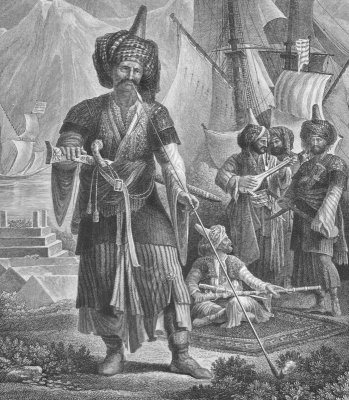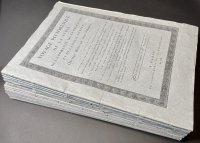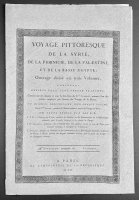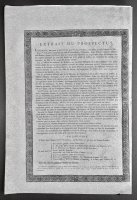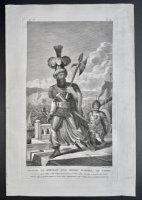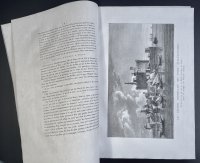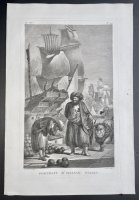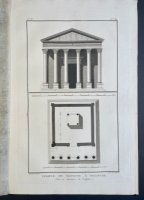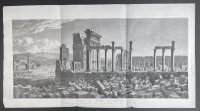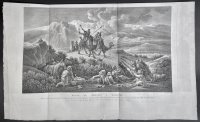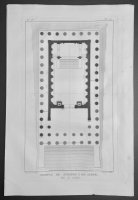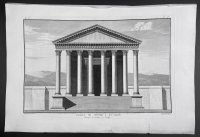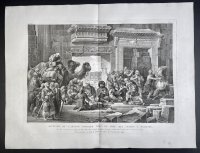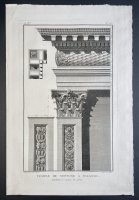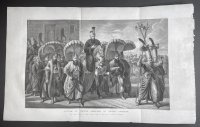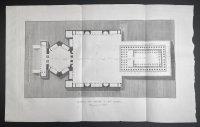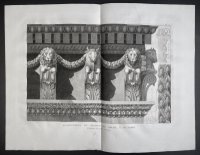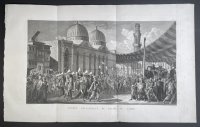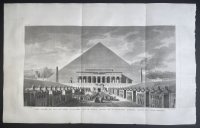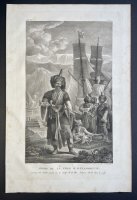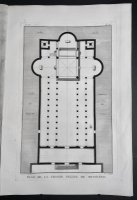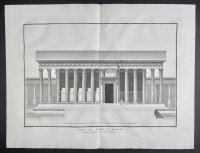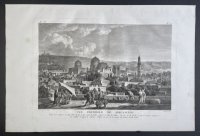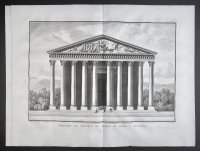Pied Oxen Printers
Louis François Cassas (1756-1827).
Voyage Pittoresque de la Syrie, de la Phoenicie, de la Palestine et de la Basse-Egypte...
...gravées sur les dessins et sous la direction de L.-F. Cassas, peintre.
$22500
Item Details
Paris, Imprimerie de la République, 1799, original blue letterpress printed wrappers.
First edition, see description and images for condition.
From Pied Oxen Printers' collection of objects related to print and book history.
25 of 30 numbered parts (“livraisons” #s 6-30) as issued in original blue printed wrappers, comprising 150 (of 180) single, double- and triple-fold plates, a number including original guards. Two parts (Nos. 6 and 8) include text pages, as originally issued. Surviving copies vary in the number of plates, but 180 plates (6 plates in each of 30 parts) is considered normal for the complete set.
Size: 13.5-14 x 20.5 inches (not including dimensions of open double- and triple-fold plates).
Condition: generally very good to excellent, with some toning, scattered foxing and a few small margin tears, none touching the image. Some of the parts and their corresponding wrappers appear to have been disbound, without damage to plates. Some wrappers have separations at the fold, while others are reattached at the folds. See images and ask any questions.
A complete inventory, including plate number, French titles with English translations, artist and names of etchers/engravers, paper and impression dimensions in inches and centimeters, and condition notes for each object will be included with the collection. One example follows:
- Bâb-êl-Foutouhh, ou la Porte des Victoires, au Caire. / Vue extérieure de cette Porte. / La Vue est prise du côté du nord-est, et sur la gauche de la rue où / aboutissent les murs de l'enceinte de La Mosquée de Hhâkem. (Bâb-êl-Foutouhh, or the Gate of Victories, at Cairo. / Exterior view of the Gate. / View of the Northeast, and on the left of the street by which / end the walls enclosing the Mosque of Hhâkem.)
Dessiné par L.F. Cassas. Gravé par Ransonnette. Terminé par M. A. Benoits.
(Engraving by Ransonnette, finished by M. A. Benoits, after drawing by L.F. Cassas.)
[Paris] : [Imprimerie de la République], [germinal an. VI [1798]]
Plate number: 3e. Ve. no. 76. Sheet: 13.625 x 20.25 in. (34.6 x 51.4 cm) Plate: 12.125 x 18.625 in. (30.8 x 47.3 cm)
Bibliographical references taken from other copies offered for sale in recent years: Blackmer II - 455 - Quérard II - 67-68 - Gay 46 - Weber II 832. Atabey 201 (179 plates); Blackmer 295 (178 plates; wrongly described as 180); RIBA 580 (183 plates); Brunet I, 1616; Cohen-de Ricci 204-5 (173 plates, and also mentions an unspecified copy with 192); Monglond IV, 993-1005 (180 plates); Tobler 134; Brunet 1, 1616; Gay 46; Ibrahim Hilmy 121; Rohricht 1498.
Louis François Cassas (1756-1827) was a distinguished French landscape painter, sculptor, architect, archaeologist and antiquary. Voyage Picturesque…"is a monumental pictorial account of his travels in the Middle East, commissioned by the French ambassador to the Ottoman court. From 1784 to 1786, Cassas lived and worked at the French embassy in Constantinople. In 1784 he accompanied the Count Choiseul-Gouffier, the French Ambassador to the Ottoman Empire, on his mission to Constantinople. Commissioned by him, he travelled from 1784 to 1787 engaged in making drawings for the Ambassador's second volume of "Voyage Pittoresque de la Grèce", published in 1809. He visited Egypt from October to December 1785, and drew the antiquities of Alexandria, the pyramids of Giza and the mosques of Cairo. Shortly afterwards he made several drawings of Palmyra, in the desert of Syria, visited the Holy Land and illustrated the ruins of Baalbec in Lebanon. He also painted Palestine, Cyprus and Asia Minor, drawing ancient Middle Eastern sites, many of which had never been recorded. At the beginning of the French Revolution, the artist returned to France via Rome, arriving in Paris in 1792. The result of his labours then appeared in the "Voyage Pittoresque de la Syrie, de la Phoénicie, de la Palestine, et de la Basse Egypte", which he began publishing in 1799. The originals of his works in oil paintings for both voyages were deposited in the Bibliothèque Royale."
Additional information about Louis-François Cassas, Artist and Architect, from “The Legacy of Ancient Palmyra,” Getty Research Institute, https://www.getty.edu/research/exhibitions_events/exhibitions/palmyra/exhibition.html (See also “Palmyra, Loss and Remembrance,” an exhibition at the Getty Villa in Los Angeles, April 18, 2018-May 27, 2019.):
"In 1784 French artist and architect Louis-François Cassas (1756–1827) traveled to the Eastern Mediterranean as part of a diplomatic mission to the Ottoman court. Cassas was commissioned by French Ambassador Marie-Gabriel-Florent-Auguste de Choiseul-Gouffier, an antiquarian and author of important works on Greece's classical past, to record the monuments of Egypt, Syria, Lebanon, Cyprus, Palestine, and Asia Minor.
During this three-year expedition, Cassas created hundreds of drawings that formed the basis of his 1799–1800 publication Voyage pittoresque de la Syrie, de la Phoénicie, de la Palestine, et de la Basse Egypte. The more than 100 large-format etchings representing Palmyra, which appear in the first volume of this publication, constitute nearly one-third of its illustrations. In 1984 Getty Research Institute acquired an extraordinary collection of "proof" or trial prints made after drawings that Cassas produced during his voyage, in addition to a manuscript written in preparation for the publication. This unpublished manuscript provides detailed notes on the architectural splendors of Palmyra's tombs, temples, aqueducts, arches, porticoes, sculptures, and friezes, with an added précis of its history, rediscovery, and exploration.
Arriving in Palmyra on either May 22 or 23, 1785, Cassas assiduously worked to record the immense quantity of ruins scattered across the landscape until departing a month later with a caravan of 500 camels heading on to Baalbek in modern-day Lebanon. Aspiring to surpass earlier publications on Palmyra, Cassas wanted to awe and inspire his European audience by lavishly documenting this great ancient city surrounded by the desert.
His panoramic etchings conform to the voyage pittoresque tradition, inviting the viewer to simultaneously marvel at the grandeur of antiquity and lament its inevitable decay. An amalgamation of orientalism and antiquarianism, the prints made from his drawings show local Bedouins inhabiting a dramatic landscape strewn with antique blocks, Corinthian columns, and monumental doorways. His primary objective to systematically record the artistry and ingenuity of this civilization is evident from Cassas's numerous technical renderings of the imposing civic and religious architecture. Floor plans and reconstructed architectural elevations are complemented by details of ornamental features.
After returning to France, Cassas became a professor of drawing at the renowned Gobelins Manufactory, where he most likely used his own ornament studies for teaching. By recasting his drawings into etchings for publication, Cassas created ready sources of inspiration for architects, painters, and designers working in the decorative arts."
Pied Oxen Printers
David Sellers
24 East Prospect Street
Hopewell, Nj, 08525
United States
Cell: 609-468-8437
Featured Catalogue
Specialities
Book Arts, Fine Press, Typography
More Information
Booth 30
Shipping and Returns
UPS, FedEx; all items guaranteed as described; returns accepted with exceptions (non-US buyers); payments by wire transfer, bank check or other by prior arrangement.Open Times
By appointment.